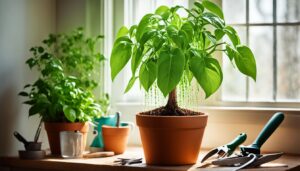Introduction:
As urbanization progresses and living spaces shrink, the allure of cultivating greenery indoors has become increasingly irresistible. Yet, the challenge of providing adequate light for thriving plant life in indoor settings persists. In such constrained environments, the reliance on natural sunlight alone may fall short of fulfilling the photosynthetic needs of various plant species. This is where the ingenious solution of employing grow lights comes into play.
In recent years, the utilization of grow lights for indoor plants has surged in popularity, offering enthusiasts and horticulturists alike a means to augment natural light or even substitute it entirely. These artificial lighting systems, meticulously designed to replicate the essential wavelengths of sunlight, have revolutionized the practice of indoor gardening, empowering individuals to cultivate lush greenery and bountiful blooms within the confines of their homes.
As we delve deeper into the realm of indoor plant cultivation, it becomes evident that the selection and utilization of grow lights represent pivotal factors in nurturing thriving flora. From understanding the diverse types of grow lights available to discerning the nuanced requirements of different plant species, embarking on this illuminating journey unveils a plethora of insights and considerations.
Join us as we illuminate the path to successful indoor gardening, exploring the intricacies of grow lights and unraveling the secrets to fostering vibrant, flourishing plant life within your home sanctuary.
Shedding Light on Grow Light Types
When venturing into the realm of indoor gardening, one of the foremost decisions revolves around selecting the appropriate type of grow light. Understanding the distinctive characteristics and benefits of each variant is essential for orchestrating optimal conditions conducive to plant growth. Below, we delineate the primary types of grow lights, along with their respective attributes and applications:
Fluorescent Grow Lights:
- Types: Compact Fluorescent Lamps (CFLs) and High-Output Fluorescent Lights (HO)
- Spectrum: Generally emit a balanced spectrum suitable for various growth stages.
- Efficiency: Relatively energy-efficient and cost-effective.
- Ideal for: Seedlings, herbs, and low to medium-light plants.
High-Intensity Discharge (HID) Grow Lights:
- Types: Metal Halide (MH) and High-Pressure Sodium (HPS)
- Spectrum: MH emits blue spectrum conducive to vegetative growth, while HPS emits red spectrum ideal for flowering.
- Efficiency: High light output but relatively higher energy consumption.
- Ideal for: Fruiting and flowering plants during respective growth stages.
Light-Emitting Diodes (LED) Grow Lights:
- Spectrum: Customizable spectrum with options for full-spectrum, red/blue, or tailored wavelengths.
- Efficiency: Highly energy-efficient with targeted light output, reducing electricity costs.
- Lifespan: Longer lifespan compared to other types of grow lights.
- Ideal for: Versatile usage across all growth stages, suitable for a wide range of plant species.
Induction Grow Lights:
- Spectrum: Generally emit a broad spectrum suitable for overall plant development.
- Efficiency: Long-lasting and energy-efficient, with minimal heat emission.
- Ideal for: Sensitive plants requiring gentle illumination, or where heat management is crucial.
Plasma Grow Lights:
- Spectrum: Offer a full spectrum similar to natural sunlight.
- Efficiency: High energy efficiency with lower heat output compared to HID lights.
- Lifespan: Longer lifespan with minimal degradation in light quality over time.
- Ideal for: High-intensity lighting needs, suitable for various plant types and growth stages.
Maximizing Grow Light Efficiency: Factors to Consider
As indoor gardening enthusiasts delve deeper into the world of grow lights, optimizing efficiency becomes paramount. Maximizing the effectiveness of artificial lighting not only promotes healthy plant growth but also ensures cost-effectiveness and sustainability. Below, we outline key factors to consider when striving to enhance grow light efficiency:
Light Intensity:
- Measure of the brightness of light reaching plants, typically expressed in lumens or foot-candles.
- Different plant species have varying light intensity requirements at different growth stages.
- Ensure adequate light intensity levels for optimal photosynthesis and growth.
Light Spectrum:
- Range of wavelengths emitted by the grow light, encompassing colors crucial for plant growth.
- Different growth stages necessitate specific light spectra: blue light for vegetative growth and red light for flowering and fruiting.
- Select grow lights with customizable or adjustable spectra to cater to diverse plant needs.
Light Duration (Photoperiod):
- Duration of light exposure provided to plants within a 24-hour period.
- Mimic natural day-length cycles to regulate plant growth stages, including vegetative growth, flowering, and dormancy.
- Use timers to maintain consistent photoperiods, avoiding disruptions to plant development.
Light Distribution:
- Uniform distribution of light across the entire plant canopy to ensure even growth.
- Position grow lights at appropriate heights and angles to mitigate hot spots and shadows.
- Employ reflectors or light movers to optimize light distribution within the growing space.
Energy Efficiency:
- Measure of the amount of light produced per unit of electrical power consumed (lumens per watt).
- Choose energy-efficient grow lights to minimize electricity costs and environmental impact.
- LED grow lights typically offer high energy efficiency compared to traditional HID or fluorescent lights.
Heat Management:
- Control and dissipate excess heat generated by grow lights to prevent heat stress and damage to plants.
- Use ventilation systems, fans, or heat sinks to maintain optimal temperature levels within the growing environment.
- Position grow lights at appropriate distances from plants to regulate heat exposure.
Plant-Specific Requirements:
- Consider the light preferences and tolerances of individual plant species when selecting grow lights.
- Research optimal light intensity, spectrum, and photoperiod for the plants being cultivated.
- Adjust grow light settings based on plant responses and growth patterns to fine-tune efficiency.
Choosing the Right Grow Light Setup for Your Indoor Garden
When embarking on the journey of indoor gardening, selecting the appropriate grow light setup is paramount to the success and vitality of your plants. With a myriad of options available, each boasting unique features and benefits, it’s essential to carefully assess your specific needs and preferences. Below, we outline the key considerations to guide you in choosing the optimal grow light setup for your indoor garden:
Determine Your Space and Plant Requirements:
- Assess the size and layout of your indoor gardening space, including available height and square footage.
- Consider the types of plants you intend to grow and their light intensity and spectrum requirements.
- Determine whether you need lighting for a small tabletop herb garden, a compact grow tent, or a spacious indoor greenhouse.
Evaluate Lighting Systems:
- Compare different types of grow light systems, such as fluorescent, HID, LED, induction, and plasma lights.
- Consider factors such as light intensity, spectrum versatility, energy efficiency, lifespan, and initial cost.
- Research reviews and recommendations from experienced indoor gardeners to gauge performance and reliability.
Calculate Lighting Requirements:
- Determine the total light output needed based on the square footage and light intensity requirements of your plants.
- Calculate the number of fixtures or bulbs required to adequately cover your growing area.
- Take into account the recommended hanging height and coverage area of each grow light system.
Budget Considerations:
- Establish a budget for your grow light setup, considering not only the initial purchase cost but also long-term operating expenses.
- Factor in potential savings from energy-efficient lighting systems with lower electricity consumption and longer lifespan.
- Prioritize quality and reliability over upfront cost to ensure optimal performance and durability.
Consider Supplementary Lighting:
- Assess whether supplemental lighting is needed to complement natural sunlight or primary grow lights.
- Determine if additional lighting is required during specific growth stages or in areas with limited natural light exposure.
- Explore options such as light movers, supplemental LED strips, or adjustable lamps to fine-tune lighting levels.
Plan for Light Placement and Distribution:
- Strategically position grow lights to ensure uniform coverage and optimal light distribution across all plants.
- Adjust the height and angle of lights to accommodate plant growth and prevent shading or hot spots.
- Use reflective materials or walls to maximize light reflection and minimize wasted light.
Tips for Efficiently Utilizing Grow Lights in Indoor Gardening
While investing in quality grow lights is essential for indoor gardening success, employing them effectively is equally crucial. By implementing best practices and adopting efficient strategies, you can maximize the benefits of your grow light system and optimize plant growth. Here are some valuable tips for efficiently utilizing grow lights in your indoor garden:
Establish a Consistent Lighting Schedule:
- Maintain a consistent photoperiod by establishing a daily lighting schedule for your plants.
- Mimic natural daylight cycles by providing 14 to 16 hours of light for plants in the vegetative stage and 10 to 12 hours for those in the flowering stage.
- Use timers to automate the lighting schedule and ensure consistent light exposure, minimizing disruptions to plant growth cycles.
Monitor Light Intensity and Distance:
- Regularly monitor the intensity of light reaching your plants using a light meter or by observing plant responses.
- Adjust the distance between the grow lights and plant canopy to achieve the optimal light intensity for your specific plant species and growth stage.
- Refer to manufacturer guidelines or consult resources for recommended hanging heights and light intensity levels for different types of grow lights.
Rotate Plants Regularly:
- Rotate plants regularly to ensure uniform light exposure and prevent uneven growth or stretching.
- Position taller plants further from the light source to prevent shading of shorter plants and promote balanced growth.
- Rotate plants at least once a week to promote symmetrical development and maximize light absorption.
- Consider Light Spectrum Adjustments:
- Tailor the light spectrum to meet the specific needs of your plants at different growth stages.
- Provide blue spectrum light during the vegetative stage to promote healthy foliage growth and compact, sturdy stems.
- Transition to red spectrum light during the flowering stage to stimulate flowering and fruiting development.
Implement Supplemental Lighting:
- Supplement natural sunlight or primary grow lights with additional lighting sources to ensure comprehensive coverage.
- Use supplemental LED strips or spotlights to target specific areas or provide extra light during cloudy days or winter months.
- Incorporate reflective surfaces or materials to enhance light penetration and distribution within the growing space.
Practice Energy-Efficient Strategies:
- Optimize energy efficiency by selecting LED grow lights with high efficacy ratings and low power consumption.
- Group plants with similar light requirements together to minimize the number of lighting fixtures needed and reduce energy consumption.
- Take advantage of natural light whenever possible and supplement with artificial lighting as needed to achieve desired light levels.
Common Mistakes to Avoid When Using Grow Lights
While grow lights can significantly enhance indoor gardening success, certain pitfalls can hinder their effectiveness and compromise plant health. By being aware of these common mistakes and taking proactive measures to avoid them, indoor gardeners can optimize their grow light setup and cultivate thriving plants. Below are some prevalent mistakes to steer clear of when using grow lights:
- Inadequate Light Coverage:
- Mistake: Failing to provide sufficient coverage with grow lights, resulting in uneven or insufficient light distribution.
- Solution: Calculate the appropriate number of grow lights needed based on the size and layout of the growing area.
- Tip: Use reflective surfaces or walls to maximize light reflection and ensure comprehensive coverage across all plants.
- Incorrect Light Spectrum:
- Mistake: Using the wrong light spectrum or failing to adjust the spectrum according to plant growth stages.
- Solution: Select grow lights with customizable spectra or use a combination of lights to provide the appropriate spectrum for each growth stage.
- Tip: Research the light spectrum preferences of specific plant species and adjust grow lights accordingly for optimal growth and development.
- Overlooking Light Intensity:
- Mistake: Neglecting to monitor light intensity levels and failing to adjust the distance between grow lights and plants accordingly.
- Solution: Regularly measure light intensity using a light meter and adjust the hanging height of grow lights to maintain optimal levels.
- Tip: Follow manufacturer recommendations or consult gardening resources to determine the ideal light intensity for different types of plants.
- Ignoring Heat Management:
- Mistake: Overlooking heat management measures, leading to excessive heat buildup and potential damage to plants.
- Solution: Use ventilation systems, fans, or heat sinks to dissipate excess heat generated by grow lights.
- Tip: Maintain adequate spacing between grow lights and plants to minimize heat stress and ensure proper air circulation within the growing space.
- Neglecting Light Duration:
- Mistake: Failing to establish a consistent lighting schedule or providing inadequate light duration for plants.
- Solution: Set up timers to maintain consistent photoperiods and ensure plants receive the appropriate amount of light each day.
- Tip: Adjust lighting schedules based on plant growth stages and seasonal changes to mimic natural daylight cycles.
- Overcrowding Plants:
- Mistake: Crowding plants together under grow lights, resulting in competition for light and space.
- Solution: Space plants appropriately to allow for adequate light penetration and airflow, preventing overcrowding and disease spread.
- Tip: Monitor plant growth and adjust spacing as needed to accommodate increasing size and prevent overcrowding.
Conclusion:
The utilization of grow lights in indoor gardening represents a dynamic and transformative approach to nurturing thriving plant life within the confines of our homes. Throughout this exploration, we’ve delved into the intricacies of selecting the right grow light setup, optimizing efficiency, and avoiding common pitfalls. As indoor gardening continues to captivate enthusiasts worldwide, the role of grow lights becomes increasingly indispensable in facilitating robust plant growth and cultivation success.
By harnessing the power of artificial lighting, indoor gardeners can overcome limitations imposed by factors such as space constraints, seasonal changes, and limited sunlight exposure. With careful consideration of factors such as light intensity, spectrum, duration, and distribution, individuals can tailor their grow light systems to meet the unique needs of their plants, promoting healthy growth, flowering, and fruiting.
As we navigate the evolving landscape of indoor gardening, the integration of grow lights opens up endless possibilities for cultivating diverse plant species, experimenting with new growing techniques, and enjoying the beauty of nature year-round. By embracing innovation, adopting sustainable practices, and continuously refining our approach, we can cultivate not only vibrant greenery but also a deeper connection to the natural world within our indoor sanctuaries.
In the journey of indoor gardening illuminated by the guiding light of grow lights, let us continue to nurture our passion for plants, cultivate thriving ecosystems, and cultivate a greener, more vibrant future within the comfort of our own homes.




